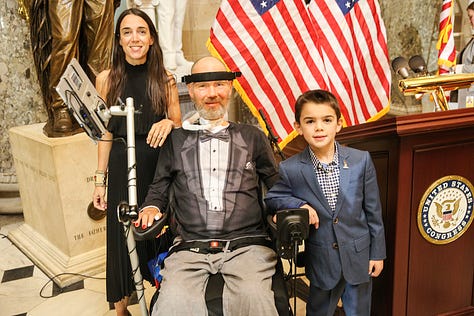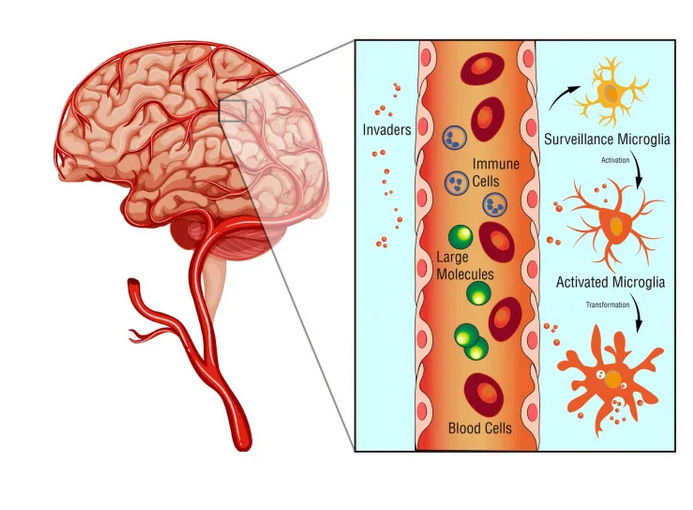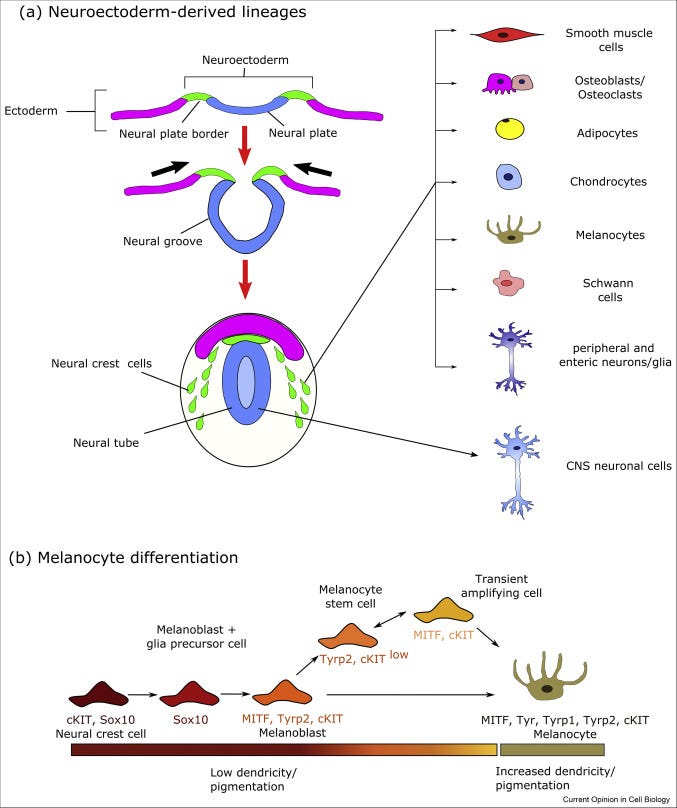Can EMF cause ALS?
Electric mitochondria, motor neurons, calcium + how statins impair nerve signaling
Here’s what we’ll learn in this article:
1. What are the current trends in ALS?
2. Why is ALS increasing in non-athletes and everyday adults?
3. How does EMF affect our immune system?
4. How are our mitochondria controlled by voltage?
5. How circadian rhythms control the death of neurons
6. What is the “glue” of our nervous system?
7. How POMC and UV helps us counter neuroinflammation
8. Can statins cause ALS?
9. Enroll for EMF Summer School!
Has anyone noticed a trend in the amount of middle-aged adults in wheelchairs?
I certainly have noticed an uptick, which inspired me to write this article.
Often called Lou Gehrig's disease, Amyotrophic lateral sclerosis (ALS) is characterized by progressive degeneration of nerve cells in the spinal cord and brain. ALS is a fatal type of motor neuron disease, where a person eventually loses their ability to breathe, suffocating to death.
Here are some statistics:
Every 90 minutes someone is diagnosed and passes from ALS
90% of cases occur without a family history
Onset is usually between the ages of 40 & 70 years
Life expectancy is 2 to 4 years
By 2040 ALS incidence is predicted to increase worldwide by 70%1
Veterans are twice as likely to develop ALS
Most of the medical community is baffled with this disease, as there is currently no known cause, and no cure. Fortunately there are many clues when we ask questions:
Why are veterans and athletes most susceptible?
Many athletes, such as the football player Steve Gleason, and combat veterans, often have head trauma. When injuries like these happen, damage to nerves occur, which can increase permeability of the blood-spinal cord barrier2, allowing more environmental toxins to enter.



Why is ALS increasing among non-athletes?
Why has there been a sudden increase among non-veterans and non-athletes?
Most adults experiencing a different type of head trauma, as they hold up their cell phone close to their neck, where the spinal cord resides, on a daily basis.
As far back as 1960, neuroscientist Allan Frey, then with Cornell University’s General Electric Advanced Electronics Center, showed that even weak electromagnetic fields can open up the blood-brain barrier. 3 4
How could this trauma then go on to cause ALS?
How does EMF affect our immune system?
Low levels of EMF (wireless radiation) release large amounts of MCP-1, a key protein that acts like a “traffic cop” (thank you Jack Kruse for that analogy) for our immune system, controlling how many white blood cells will be able to cross the road, so that we can combat inflammation. However, when we have too high of a level of MCP-15 by being exposed to EMF, this can disrupt6 our repair mechanism.
Too many non-native electromagnetic frequencies create confusion, as we have too many MCP traffic cops on patrol - giving our immune system mixed signals:
You may be asking, how is a cell phone capable of doing this?
Voltage controls our mitochondria
If you’ve ever gotten an electroencephalogram (EEG), you know that our brain’s health can be assessed by measuring miniscule electrical signals. Our motor neurons, which are impaired in ALS, have more mitochondria than our sensory neurons. Our mitochondria are our bodies’ factories of life, and produce the energy molecule ATP, which also helps stabilize proteins.
It turns out that our mitochondria are also controlled by voltage7 e.g. EMF. Our mitochondria contain what are known as voltage-dependent anion channels (VDAC). When exposed to EMF, VDACs reduce the ATP available for our nervous system to use.
Our mitochondrial membrane also controls how much calcium gets in and out of our cells. Calcium ions initiate and regulate responses of central nervous tissues to injury. However, the amount of calcium our mitochondria need can also be altered, as EMFs can disrupt our voltage-gated calcium channels.8
What came first: the wireless chicken or the egg of blue light?
Our bodies heal and regenerate while we sleep in two ways - using the Earth’s restorative magnetic field (native EMF), along with the absence of light. No matter what type of damage we may do to our bodies during the day, we always have a chance to repair at night.
Even though many of us don’t have the necessary healing architecture of a sleep sanctuary free of all non-native magnetic fields, we can still drastically improve our ability to repair - by removing blue light at night.
How can our modern light environment alter one’s outcome with ALS?
What we do reverberates in eternity
Rev-erbα, is a nuclear transcription factor that is part of our molecular clock, which encodes circadian rhythms. Put another way, Rev-erbα translates what our DNA ultimately tells our bodies’ nervous, immune, and hormonal systems on how to function by expressing certain genes.
How are these genes expressed in an efficient manner?
By syncing their “notes” to the melodies of Sunlight.
When tuned correctly, Rev-erbα can effectively regulate inflammatory and immune responses, as well as apoptosis - programmed cell death.
“Circadian disruption in the anterior motor neurons causes a paralysis like effect that we normally see in REM sleep. In ALS, the circadian disruption shows up when we’re awake and it has gone unrecognized as a completely disrupted rhythm disorder.”
~ Jack Kruse
When out of alignment with the natural variability of our light environment, processes like apoptosis (programmed cell death) run amuck, leading to the atrophy of motor neurons, as well as a loss of communication to other brain cells called astrocytes.9
Glia - the Glue of our Neuroimmune System
Astrocytes make up the majority of cells in the human central nervous system (CNS), and perform metabolic, structural, homeostatic, and neuroprotective tasks such as clearing excess neurotransmitters, stabilizing and regulating the blood-brain barrier, and promoting synapse formation.10
Microglia are our brain’s protectors, and facilitate communication of immune cells across our blood-brain barrier so that they can clean up toxins.
For example, microglia remove neurons that don’t communicate properly, thus ensuring that information transfer between neurons is not interrupted. These also help clean up clumps of abnormally shaped proteins that accumulate and are associated with neurodegenerative diseases.
Rev-erbα acts like the referee of our brain’s immune system, by regulating how many microglia become activated when we have any type of neuroinflammation between the CNS and our gut.

UV builds POMC
When we expose ourselves to AM Sunlight, along with the UV that comes later in the day, we’re able to make a critical protein precursor (makes other proteins) known as POMC.
POMC creates melanin from what are known as neuroectodermal derivates:
Why is this important?
Melanin helps us fight inflammation, along with chronic diseases such as cancer. These neuroectodermal derivatives directly connect to the mitochondria in the brain.
What else do we produce in UV-A Sunlight?
Nitric Oxide. No - not like the nitrites found in sausage, or the nitrous oxide used in Fast and Furious. This molecule dilates our blood vessels, aids our immune system, and can even increase brain function.11 When we stay indoors too long, our circulation is hampered, and we wind up with proteins that act like shrapnel in our blood.
Can statins cause ALS?
Not directly - but they can certainly contribute to this disease. Statins work by decreasing cholesterol. However, the synapses of our nervous system are made, primarily, of cholesterol.
Cholesterol is required to maintain the health of the myelin sheath, that surrounds and protects neurons. Glial cells in the brain, like the microglia mentioned above, sustain the myelin sheath by synthesizing their own cholesterol and transferring it across to neurons.
The two most widely prescribed statins are simvastatin and atorvastatin. Atorvastatin increases risk for ALS seventeen fold, and simvastatin twenty three fold. There’s even one statin, Lovastatin, that increases the risk for ALS 107 times!12 This is based on a 2018 study published in the Journal Drug Safety. ‘Amyotrophic Lateral Sclerosis Associated with Statin Use A Disproportionality Analysis of the FDA’s Adverse Event Reporting System:
Doctor Malcolm Kendrick is a Scottish doctor, author, and speaker, who has been investigating the reckless use of statins and the false narrative of cholesterol. Dr. Kendrick made the following point regarding the statin-ALS statistics, which I find notable:
“It is often said that association does not mean causation. However, this is only true up to a point. Most statisticians agree that an odds ratio > 6 represents proof of causation. When you find that people taking atorvastatin have a seventeen-fold increase in risk of ALS, this is proof of causation. The effect is too massive to be due to anything else.”
Where do we go from here?
Out of our blue night, and into the Sunlight.
We are more powerful than we know,
Roman & Bohdanna
If you’ve found this article valuable, would you consider sharing it?
Join us as we greet 2025 with the light 🔥 of our ancestors -
Illumination. Knowledge. Vitality.
Support us at The Power Couple Bookshop - dedicated to making us relearn from our ancestors!
Echeverry S, Shi XQ, Rivest S, Zhang J. Peripheral nerve injury alters blood-spinal cord barrier functional and molecular integrity through a selective inflammatory pathway. J Neurosci. 2011 Jul 27;31(30):10819-28. doi: 10.1523/JNEUROSCI.1642-11.2011. PMID: 21795534; PMCID: PMC6623085.
Magri A., Messina A. Interactions of VDAC with proteins involved in neurodegenerative aggregation: An opportunity for advancement on therapeutic molecules. Curr. Med. Chem. 2017;24:4470–4487. doi: 10.2174/0929867324666170601073920.
Pall ML. Electromagnetic fields act via activation of voltage-gated calcium channels to produce beneficial or adverse effects. J Cell Mol Med. 2013 Aug;17(8):958-65. doi: 10.1111/jcmm.12088. Epub 2013 Jun 26. PMID: 23802593; PMCID: PMC3780531.
Killoy KM, Harlan BA, Pehar M, Vargas MR. NR1D1 downregulation in astrocytes induces a phenotype that is detrimental to cocultured motor neurons. FASEB J. 2022 Apr;36(4):e22262. doi: 10.1096/fj.202101275R. PMID: 35319791; PMCID: PMC9223394.
https://www.ncbi.nlm.nih.gov/books/NBK545142/









Hi Roman. I haven't read all your article yet as I just found it at bedtime but couldn't find any reference to Dr Neil Cherry, an atmospheric physicist, who died in I think 2003 of ALS, although we mostly call it MND, for motor neurone disease, in New Zealand. He did a lot of work on the relationships with health and EMF and was highly respected.
Have a look at the 4th from bottom paper under "Papers". I haven't read any of these for many years but there is a treasure trove of information. https://neilcherry.nz/blog/
Treasure Article!! Even though I am no medical expert, I got so much valuable information!!! Way to go! Much appreciated Sir 🙏